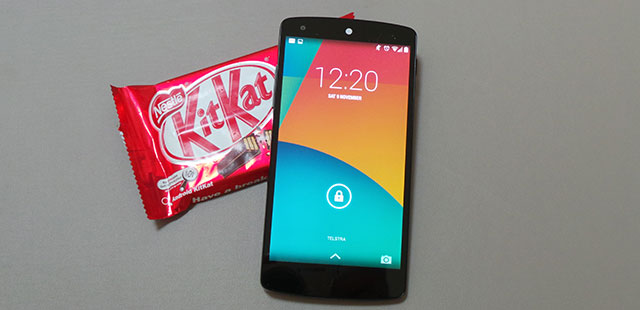
Ending months of speculation and leaks, Google finally announced the Nexus 5 last Friday, and this week a number of Ausdroid team members received their shiny new phones. With a choice of black or white phone available at launch for the first time for a Nexus device, we’ve also got a nice split of white and black devices to play with.
While we’ll bring you a full review of the device and Android 4.4 KitKat in the coming weeks, we thought it would be a good idea to bring you our initial thoughts after nearly a week using our phones.
Black or White, it’s what inside that counts
The most surprising thing we’ve found is that there’s a difference between the black and white back plates. The white is smoother and much more solid plastic and in fact feels not unlike the Moto X, while the black uses the same “soft touch” material we’ve seen Google use on the Nexus 7 and CR48 Chromebook over the past few years.
Regardless of colour choice, the phone feels great in the hand and sports the same great 5-inch 1080p display rocking its 445 PPI pixel density. Put up against a Galaxy S4, the screen could be accused of looking “washed out”, but that complaint’s been levelled against every Nexus device since the 2012 Nexus 7 (where it was, probably, a fair criticism). The screen seems accurate rather than washed out, and it seems the max brightness setting is quite strong.
As it’s not an AMOLED screen, colours don’t pop like they do on a Galaxy S4, although that tends to give an unnatural vibrance to the picture and makes for an unfair comparison. Google’s devices also don’t dynamically alter the characteristics of the display, either.
More concerning is the 2300 mAh battery that’s sealed inside the device. Nobody seems to have been terribly impressed by the Nexus 4’s battery life last year, and this only offers a slight bump. In theory, the new “fused location” service should take the bite out of apps using location services, but that’s only part of the picture. My Nexus 5’s battery life seems to have fluctuated pretty wildly over the course of the week, from only lasting a few hours with the screen on during the week to almost 5 hours of near-constant Ingress gameplay last night. Time will tell.
All of this completely ignores the speed demon inside. The Snapdragon 800 and the seemingly-standard 2 GB of RAM makes this one of the fastest Android devices around. It’s responsive and speedy and I haven’t been left waiting for anything while using the phone. It’ll be interesting to see how this performs over time – while Android devices tend to have a reputation for slowing down as they age, last year’s Nexus 4 still seems pretty snappy as well. Maybe Google’s finally nixed that annoyance.
The Insane Camera
Earlier this year, Google’s Vic Gundotra indicated that Google was committed to making Nexus phones “insanely great cameras”. Given that Google’s had some pretty lacklustre cameras in their Nexus devices to date, the comment set rumours in motion and they really haven’t stopped ever since. Has Google succeeded?
It feels like the result depends on who you talk to. The Nexus 5 is certainly capable of delivering great results in well-lit conditions, but that’s become table stakes these days – you don’t earn any points for taking a good picture in perfect conditions.
We’ve had mixed results amongst the team, but Geoff in particular seems to be enjoying it, finding the results sharp and accurate, even in low-light situations. He’s also enjoying the new HDR+ mode.
The downside? The camera’s not all that fast. It takes time to launch, and where the Galaxy Nexus and Nexus 4 before it had extremely quick (some would say too quick) cameras, the Nexus 5 seems to take its time focusing and likes to hunt around the frame. This might make it less suited for fast action photography but great for still shots like scenery and landscapes.
The default camera app also seems to be showing its age – while it offers things like scene presets and colour temperature configuration, it doesn’t allow you to overlay a grid on the screen to help you line up your photos, and the arc-style navigation (an evolution of the circular navigation of years past) feels particularly unintuitive and out of place.
Tasty KitKats
The general consensus among the team so far is that Android 4.4 doesn’t attempt to change something that’s not broken. Google hasn’t made major changes to the way Android works, but rather refined and evolved its UI and design language.
It also seems to have borrowed a little from some of its major OEMs.
HTC started using a narrow Roboto font on the One, and that font now seems to be in use in the KitKat launcher UI and system-wide “toast” messages. Google also seems to have ceded to Samsung’s use of a clockwork cog for Settings, although you’ll still find Android’s traditional “3 sliders” settings icon in use elsewhere. The translucent notification / soft keys bar also seems like a play borrowed directly from the OEM’s 2013 flagships. Now, if only Google would follow LG’s lead and allow users to configure their soft keys…
Another obvious visual change is the white theme used throughout the OS. The keyboard is now grey and white, while most icons in the notification bar are white. It’s neat & consistent, although it’s also lead to the removal of some information. The data transfer arrows no longer appear in the signal strength indicator, and you can now no longer see when you have a solid connection to Google’s servers. You can still see this information in the Quick Settings area, though this doesn’t seem nearly as useful. Hopefully something Google will address in a point release.
Another welcome change is that you now have a dedicated “Home” section in Settings to make selection of your default launcher simpler. Previously you’d have to find your launcher in the list and clear its defaults to trigger the app selector.
One thing I wish they’d adopted from HTC is their implementation of Android 4.2 and above’s Quick Settings. The feature first appeared on last year’s Nexus 4 and almost immediately started to attract criticism for its lack of configuration options, and it disappointingly remains virtually unchanged in KitKat.
Lastly, it’s disappointing that in this day and age there’s still no Australian English locale for a device that’s so obviously popular here…

We’ve only scratched the surface of what the Nexus 5 and Android KitKat have to offer, and we’ll delve into the device and the OS in more detail our full reviews.
Do you also own a Nexus 5? Tell us what you like – or don’t like – about it in the comments!




